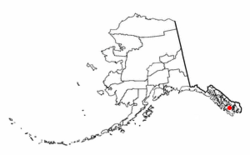Whale Pass, Alaska facts for kids
Quick facts for kids
Whale Pass, Alaska
|
|
|---|---|
|
Second Class City
|
|

Location of Whale Pass, Alaska
|
|
| Country | United States |
| State | Alaska |
| Incorporated | 2017 |
| Area | |
| • Total | 28.01 sq mi (72.54 km2) |
| • Land | 19.86 sq mi (51.43 km2) |
| • Water | 8.15 sq mi (21.11 km2) |
| Elevation | 128 ft (39 m) |
| Population
(2020)
|
|
| • Total | 86 |
| • Density | 4.33/sq mi (1.67/km2) |
| Time zone | UTC-9 (Alaska (AKST)) |
| • Summer (DST) | UTC-8 (AKDT) |
| ZIP Code |
99927, 99950
|
| Area code(s) | 907 |
| FIPS code | 02-84000 |
| GNIS feature ID | 1744590 |
Whale Pass is a small city in Prince of Wales-Hyder Census Area, Alaska, United States. It is known as a "second class city." In 2010, 31 people lived there. By 2020, the population grew to 86 people.
Contents
Where is Whale Pass?
Whale Pass is located in Alaska at coordinates 56.112370 degrees North and 133.141892 degrees West.
The city covers a total area of about 37.4 square miles (96.9 square kilometers). Most of this area, 35.6 square miles (92.2 square kilometers), is land. The rest, about 1.8 square miles (4.7 square kilometers), is water.
How Many People Live There?
| Historical population | |||
|---|---|---|---|
| Census | Pop. | %± | |
| 1980 | 90 | — | |
| 1990 | 75 | −16.7% | |
| 2000 | 58 | −22.7% | |
| 2010 | 31 | −46.6% | |
| 2020 | 86 | 177.4% | |
| U.S. Decennial Census | |||
Whale Pass first appeared on the U.S. Census in 1980. It was called "North Whale Pass" back then. In 1990, its name was shortened to just "Whale Pass."
On January 31, 2017, the people living in Whale Pass voted to make it an official city. It became a "second-class city."
In 2000, there were 58 people living in Whale Pass. Most of the people were White. A small number were Native American or of two or more races. Some people were also of Hispanic or Latino background.
There were 22 households in 2000. About 36% of these households had children under 18. The average household had about 2.64 people. The average family had about 2.92 people.
The population was spread out by age. About 26% were under 18. About 33% were between 25 and 44 years old. About 35% were between 45 and 64 years old. The average age was 37 years.
History of Whale Pass
Whale Pass started as a place for logging, which means cutting down trees for wood. It was first recognized in 1980 as "North Whale Pass." Later, its name was changed to simply "Whale Pass."
For many years, it was an unincorporated place. This means it did not have its own city government. But on January 31, 2017, the people of Whale Pass voted to become an official city. Almost 75% of the voters agreed. This made Whale Pass the 116th "second-class city" in Alaska.
Education in Whale Pass
The school in Whale Pass is called Whale Pass School. It is managed by the Southeast Island School District.
See also
 In Spanish: Whale Pass (Alaska) para niños
In Spanish: Whale Pass (Alaska) para niños

